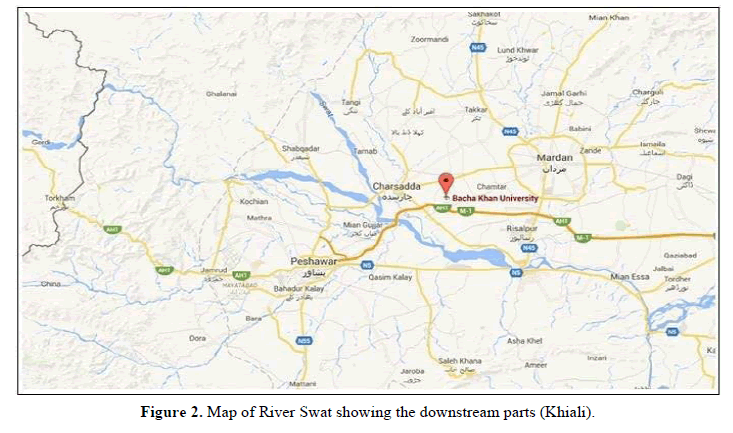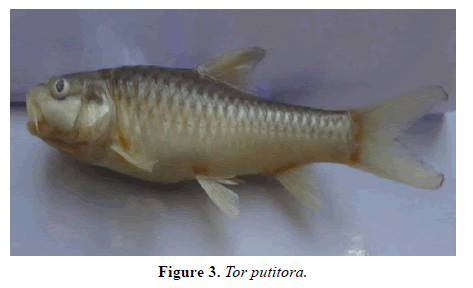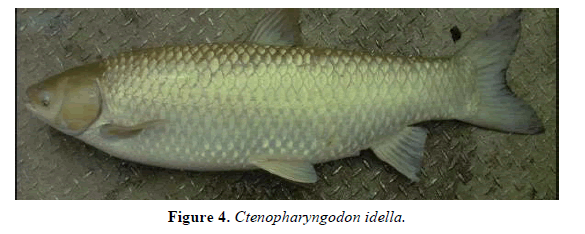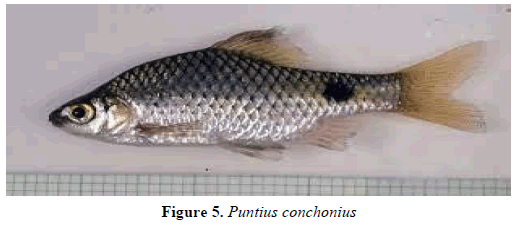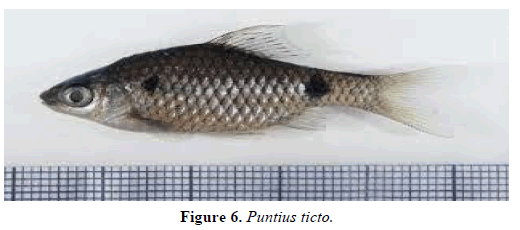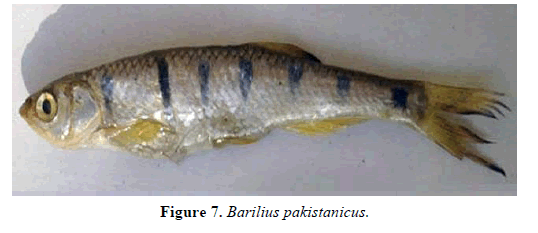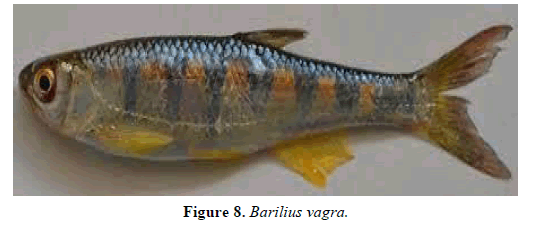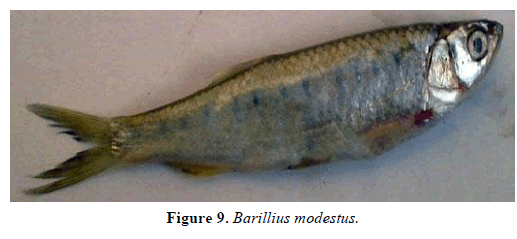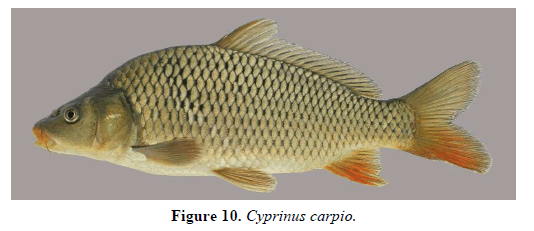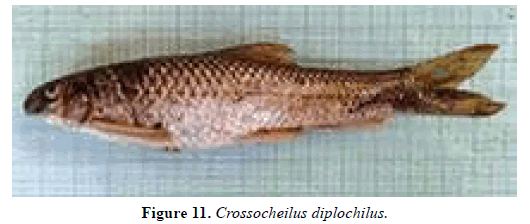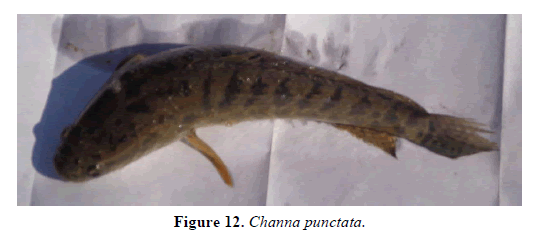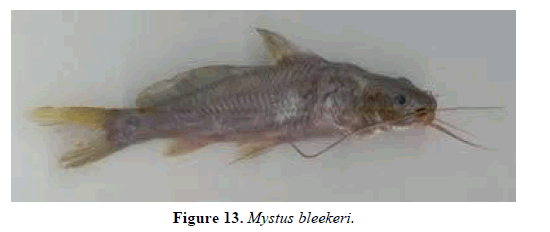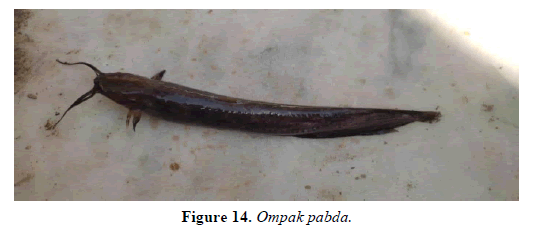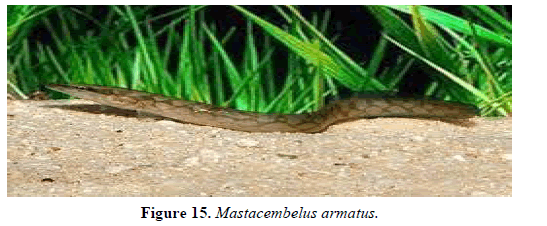Research Article - International Journal of Pure and Applied Zoology (2023) Volume 11, Issue 1
BIODIVERSITY OF FISH FAUNA OF RIVER KHIALI AT DISTRICT CHARSADDA, KHYBER PUKHTOONKHWA, PAKISTAN
Saud Iqbal*and Madam Lubna
Deparment of Zoology Islamia College University Peshawar, Khyber Pakhtunkhwa, Pakistan
- Corresponding Author:
- Saud Iqbal
Deparment of Zoology
Islamia College
University Peshawar
Khyber Pakhtunkhwa, Pakistan
E-mail: saudiqbal5555@gmail.com
Received: 01-Dec-2022, Manuscript No. IJPAZ-22-82027; Editor assigned: 05-Dec-2022, PreQC No. IJPAZ-22-82027(PQ); Reviewed: 19-Dec-2022, QC No. IJPAZ-22-82027; Revised: 27-Dec-2022, Manuscript No. IJPAZ-22-82027(R); Published: 03-Jan-2023, DOI: 10.35841/2320-9585-11.1.161
Abstract
The present day study was conducted at River Khiali, District Charsadda to find out ichthyo- diversity of the River. The collection of ichthyo was from May, 2022 to August, 2022. During study fishes were collected by different technique i.e. cast net, rectangular nets and other legal effort. During this investigation time 13 species were collected and identified. These species belonged to 4 orders including Cypriniformes, Channiformes, Siluriformes, and Mastacembeliformes. The order further consists 5 families including Cyprinidae, Channidae, Bagridae, Sisoridae, Mastacembelidae. Order Cypriniformes is the dominant and richest order of the river, including Tor putitora, Ctenopharyngodon idella, Puntius ticto, Puntius conchonius, Barilius pakistanicus, Barilius vagra, Barilius modestus, Cyprinus carpio and Crossocheilus diplochilus. Order Channiformes has single family channidae represented by single specie which is Channa punctata. Order Siluriformes has 2 families namely Bagridae, and Siluridae represented by single specie Mystus bleekeri and Ompak Pabda respectively. Family Mastacembelidae comprises single specie named Mastacembelus armatus. It was concluded that River Khiali at District Charsadda has got high fish biodiversity and has got potential to be utilized for culturing various other cold water fishes.
Keywords
Diversity, Fish Fauna, River khiali, Charsadda, KPK.
Introduction
Fishes are cold blooded vertebrates adapted to live in water. They respire by means of gills and have paired appendages, if any in the form of fin [1]. A poikilothermic, aquatic chordate with appendages (when present) developed as fins and respire by means of gills and body is covered with scales [2]. Or more simple, a fish is an aquatic vertebrate with gills and limbs in the shape of fins [3].
Fishes are the most ancient and abundant vertebrate. Approximately 40,000 species of vertebrates, a total of 21,723 species belong to super class Pisces [4]. Fish exhibit a great diversity in shape, size and color according to their habitat. Biodiversity is the variety of species in the ecosystem, or variety of life on earth [5].
Fishes are ranging in size from very small to very large body plane. For example; the smallest fish of fresh water is Pandaka pygmae while Trimmatous nannus is considered as shortest marine fish. Rhinocodon, a cartilaginous shark, is the largest fish [6]. The weightiest bony fish in the world is Sunfish (Mola mola) which live in tropical and subtropical aquatic habitats [7]. Fishes are classified according to their shapes. For examples; flattened (skates), snake-shaped (eel), moonfish type, flatfish type (flounder), spherical (globe fish), arrow-shaped (garpike), torpediform (mackerel), and ribbon shaped (king-herring).
With few exceptions fishes are oviparous however they are not a few members of this class which show modification of one or more of these characteristics, as we shall see hereafter, and which, nevertheless cannot be separated from it [8].
Fish attain having significance in a number of ways. It is a handy sector, boosting the economy of many countries [9]. It is also a stapled food item on account of its nutritional and medicinal values [10]. Fisheries sector is also providing employment to millions of people throughout the world [11]. Fishes also play a crucial role in the second tropic level of the aquatic ecosystem [12]. Due to size and abundance of fish they are easily sampled research objects that provide information crucial for management and our understanding of freshwater ecosystem [13].
Fishes are one of the important creatures of animal kingdom found below -2°C of Antarctic region to hot spring of California where temperature is high as 52°C with a wide range distribution. The altitudinal distribution ranges from 5000m above sea level to some 11,000 beneath it [14]. Fishes may tolerate a high range of salinity as well.
In the Holy Quran, Allah says, “It is He, Who subjected to your ocean so you may eat of its fresh fish and bring up from it ornaments with which, to adorn your person”.
Biodiversity of fishes
According to fish base 34,300 species of fish had been described as September 2020. That is more than combined total of all other Vertebrates species, mammals, amphibians, reptiles, and birds. Fish species diversity rough divided equally between marine (oceans) and freshwater ecosystem. Coral reefs in the indo-pacific constitute the center of diversity for marine fishes, whereas continental freshwater fishes are more diverse in large river basins, of tropical rainforest, especially amazon, Congo, and Mekong basins. More than 5600 fish species inhibit. Neotropical fishes represent about 10% of all vertebrates species on the Earth [15].
Freshwater fish species are classified into two groups based on their ancestor postulated habitats. The first group is known as primary freshwater species because they emerge for the first time from freshwater and account 8000 species. The second group comprised of 1500 species supposed to be originated from marine ones and termed as secondary freshwater species [16].
Fishes show the greatest biodiversity of the vertebrates with over 22,000 species. Out of these approximately 58% are marine, 41% are freshwater species and 1% move back and forth between marine and freshwater. As estimated marine fish are the more diverse because saltwater covers 70% of the earth. Only 1% of the earth is covered by freshwater. This small area is home to 8,000 species of freshwater fishes [17]. There are almost 28,000 known extant species of which almost 27,000 are bony fish with 970 sharks, rays, and chimeras and about 108 hagfish and lampreys.
About 180 species of fish have been reported in Pakistan, including representative from important group such as loaches, carps and catfish. 28 fish species listed as living in cold water of Pakistan. Most of the snow trout are restricted to the trans Himalayan region of the Indus river. In Pakistan different studies were carried out to know about the fish biodiversity in different areas. These studies describe different species distribution pattern and provide reference line information about endangered species. But the drawback of these studies is that no one studies comprehensively, which can describe importance of species and conservation methods of endangered fish species [18].
Nutrition in fishes
Some fish only eat plants and others only eat animals. However, the majorities of aquarium fishes are omnivores and eat both plants and animals. It is important to match the type of food to the type of fish.
The diet offered needs to be appropriate to meet these different needs. In other words, it should deliver an appropriate amount of different nutrients, and be in a format that the fish can easily eat. A good quality prepared food will provide fish with a balanced diet. This will include nutrients such as protein, fats, vitamins and minerals. Some fish food contains pigment enhancers, to bring out the natural colors of the fish (e.g. in the form of ingredients such as shrimp meal, Spirulina algae, and lutein).
Some species of fish are unable to make their own vitamin C and so must be provided with this nutrient in the diet. Essential vitamins including A, C, D, E and K are supplied in most complete fish foods [19].
Importance of fishes
Fish farming is one of the most important sectors of a country economy. It is a rich source of protein which is an important component of our diet [20]. It is also getting medicinal important on fish liver is used in many medicines [20]. Fish are not only useful as a source of food , medicines and economic value but it is also playing a vital role in the second trophic level of the aquatic ecosystem [12].
Fisheries sector can play an important role in the economy of Pakistan due to its export potential source of employment and supplying animals protein which are necessary for body growth. Thus fish industry has great contribution in our foreign exchange. Pakistan exported fish worth R.s 3.384 billion (65.433 million) during July–October 1999 as compared to 1998 which was R.s 2.539 billion (50.653million) (daily frontier post Dec, 1999).
Pakistan fishery provides employment to about 100,000 fishermen directly. In addition, another 400,000 people of employment in ancillary industries. It is also a major source of export earnings. IN July-may 2002-13fish and fisheries product valued at US S 117 million were exported from Pakistan (Fisheries development board, PK, 2008).
The fish production of KP during 1998 -99 was 694.377metric ton worth of R.s 29.649 million as compared to 1997-98 which was 752.036 metric-tons worth of R.s 12.798 million (KP Fisheries statistics, 2000).
The importance of fish is like the dawn of the day which cannot be neglected as we know about slogan. “The more the fish the more the money”.
History of research area
The present-day Charsadda, one of the capitals of Gandhara, is known by different names in its long and rich history. The most prominent among them are Pushkalavati, Hashtnagar and now Charsadda. The district of Charsadda, known in early history as Pushkalavati, is situated in the center of Peshawar valley from the time immemorial, its economy is agricultural based, which is depended on the availability of sufficient quantity of river water, drawn from the rivers flowing in its terrain. The Swat and Kabul rivers meet here and its numerous branches enrich the lands of this area, making it really the bread basket of the Peshawar valley.
Geography of research area
Charsadda is 17 miles from Peshawar located in the west of Khyber Pakhtunkhwa Pakistan and is bounded by Malakand District on the north. Mardan district on the east, Nowshera and Peshawar districts on the south and the Mohmand Agency of the Federally Administered Tribal Areas on the west. This district has one of the most fertile lands in Khyber Pakhtunkhwa Pakistan.
The total area of the district is about 996 square kilometers (243753 acres). Total cultivated area is 210255 acres (61 %), irrigated area is 180339 acres, i.e. 86% of the total cultivated area. There are three rivers flowing in Charsadda: The River Jindi, The Kabul River, and The Swat River; these are the main source of irrigation for Charsadda. The three rivers then merge and join the Indus River. The area surrounded by River Swat and River Kabul is called Doaaba and has a great importance in the District.The district is administratively subdivided into two Tehsils which contained a total of 46 Union Council.
The population of Charsadda according to the year 2000 is 1.7 million. Charsadda having the density 1081 person/Sq.Km. Its Literacy rate is 43.09%. Employment position according to the year 2000 are 165574 are Employed and 49531 are Unemployed. All major infrastructures are available for communication in which 352 km as High Type Road in district Charsadda. But the Railway facility are still awakened Water and Electricity facility are available. The main languages are Urdu and Pashto.
Aims and objectives
1. To identify fish fauna of river swat at Khiali in district Charsadda. 2. To determine the most prevalent fish orders. 3. To explore fish diversity of Khiali river.
Materials and Methods
River khiali
River khiali is one of the mian water ways flowing through Khyber Pakhtunkhwa Pakistan. The word khiali means ideal, the river being an ideal and popular spot in the native history. Geographically khiali is a downstream strip river swat. The river swat originates as gushing stream from the perpetual ice caps of mejestics mountains of swat kohistan. It rejuvenates at kalam with the union of ushu and utror river and flows for about 160 kilometers across valley of chakdara. The river flows narrowly and swifty from kalam to madyan never acquiring more than an average width of 35-40 Km. The narrow course of the river continues Thalapand. From swat district it runs through lower dir, meeting with the panjkora river, flowing through malakand it enters Peshawar from where it enters charsadda after covering an approximate distance of 15 km [21]. This is the district where it comes to be known as khiali. The journey of the rivers continues, having yet another mergence, this time with river sardaryab about 16km south west proper charsadda is shown in (Figure 1).
Study area
Charsadda is a town and headquarter of charsadda District, in the Khyber pakhtunkhwa province of Pakistan. Pashtuns make up majority of the population of the district. The district lies between 34-03’ and 34-38’ north latitudes and 71-53’ east longitudes. Charsadda is located in the west of Khyber pakhtunkhwa and is bounded by Malakand district on the north, Mardan on the east, Nowshera and Peshawar districts on the south and Momand agency of the federal administered tribal areas on the west. The total area of this district is 996 Km2. This district is subdivided into three tehsils which contained a total of 49 union councils is shown in (Figure 2).
Sampling
Sampling was performed from different locations to investigate the fish diversity. The sampling was carried out from May 2022 through August 2022. Different types of nets and hooks and of various mesh sizes were used for collecting fishes.
Preservation of fishes
The collected fishes were washed with tape water before putting in Ethanol solution. Then the fishes were preserved in formalin solution. Small fishes were preserved as such in formalin solution while large specimens were injected with Formalin in the belly. The fishes were placed in separate jars according to the size of the specimen.
Laboratory work
The preserved fishes were brought to the laboratory, Department of Zoology Islamia College University Peshawar. The fishes were sorted out in different groups on the basis of similarity and differences. For this purpose number of barbles, insertion of fins, appearance of head, dorsal and ventral profiles, caudal fin, length of fins and body shape were considered.
Surgical gloves and safety spectacles were used during the handling of fishes for protection of hands and eyes from formalin. Large forceps were used for taking out fish from a jar. Fishes were washed with tap water before studying. The fins, scale and lateral line were studied using a magnifying lens.
Keys used
The fishes were identified to specie level. The following Keys and literature were used for identification of fishes.
1. The Freshwater Fishes of the Indian Region Narendra Publishing House Delhi-110006 (India) [4].
2. Mirza and Sandhu, (2007) Fishes of Punjab Pakistan Polymer Publications Lahore [22].
3. Mirza. (1990) Pakistan Ki Taza Pani Ki Machlian (in Urdu) Urdu Science Board, 299- Upper Mall Lahore [23].
4. Mirza. (1973) Aquatic Fauna of Swat Valley, Pakistan, Part 1 Fishes of Swat and Adjoining Areas [24].
Result
The present survey conducted at river Khiali from May 2022 to August 2022 yielded a total of 13 species belonging to 4 order and 5 families is shown in (Table 1).
| S. No | Class | Order | Family | Genus | Species |
|---|---|---|---|---|---|
| 01 | Actinopterygii | Cypriniformes | Cyprinidae | Tor | Tor putitora |
| 02 | Actinopterygii | Cypriniformes | Cyprinidae | Ctenopharyngodon | Ctenopharyngodon idella |
| 03 | Actinopterygii | Cypriniformes | Cyprinidae | Puntius | Puntius conchonius |
| 04 | Actinopterygii | Cypriniformes | Cyprinidae | Puntius | Puntius ticto |
| 05 | Actinopterygii | Cypriniformes | Cyprinidae | Barilius | Barilius pakistanicus |
| 06 | Actinopterygii | Cypriniformes | Cyprinidae | Barilius | Barilius vagra |
| 07 | Actinopterygii | Cypriniformes | Cyprinidae | Barilius | Barilius modestus |
| 08 | Actinopterygii | Cypriniformes | Cyprinidae | Cyprinus | Cyprinus carpio |
| 09 | Actinopterygii | Cypriniformes | Cyprinidae | Crossocheilus | Crossocheilus diplochilus |
| 10 | Actinopterygii | Channiformes | Channidae | Channa | Channa punctata |
| 11 | Actinopterygii | Siluriformes | Bagridae | Mystus | Mystus bleekeri |
| 12 | Actinopterygii | Siluriformes | Siluridae | Ompak | Ompak Pabda |
| 13 | Actinopterygii | Mastacembeliformes | Mastacembelidae | Mastacembelus | Mastacembelus armatus |
Table 1. Taxonomic Position of Fishes collected at River Khiali, Charsadda.
Tor putitora (Figure 3)
Common name: Mahseer
Systematic position
Class: Actinopterygii
Order: Cypriniformes
Family: Cyprinidae
Genus: Tor
Species: Tor putitora
Characteristics
Fin formula: (D iv 8; A ii 5; P i 16-17; vi 8)
Color: Its dorsal side was greenish; sides light pink and ventral side was silvery white. Fins color was reddish yellow. Mostly found in rapids of river with rocky bottom.
Habitat: Inhibits running streams and rivers.
Distribution: It was reported from different parts of Pakistan i.e. from KPK, Azad Kashmir, Punjab, from River Kabul at Warsak dam, from river Swat at Charsadda.
Size: It has been known to reach 2.75 m in length.
Feeding: Green filamentous algae, insect larvae, small molluscs, and algal coatings on rocks.
Morphometric measurement Total length: 12.9 cm
Standard length: 10.5 cm
Fork length: 11.8 cm
Head length: 2.9 cm
Ctenopharyngodon idella (Figure 4)
Common name: Grass Carp
Systematic position
Class: Actinopterygii
Order: Cypriniformes
Family: Cyprinidae
Genus: Ctenopharyngodon
Specie: Ctenopharyngodon idella
Characteristics
Fin formula: D. 3/7, P1. 1/17, P2. 1/8, A. 3/7-8.
Color: Adult wild carp are typically brown to olive on the back fading to brassy or gold on the sides with no conspicuous spots or markings. Domestic pet stock carp (koi) may be very heavybodied with a variety of bright colors, including black, white, red, pink, orange, yellow or some combination of these.
Habitat: Rivers, lakes, canals, beels, baors etc. Both open and closed water bodies. Distribution: Pakistan: KPK, Punjab, Baluchistan, Sindh. India, China, Uk.
Size: 10.7 cm SL
Feeding: Grass carp are herbivorous and feed primarily on aquatic plants but also take insects, and some other invertebrates (aquatic worms, crustaceans, and mollusks etc).
Morphometric measurements:
Total length: 9.5 cm
Standard length: 8.0 cm
Fork length: 6.4 cm
Head length: 1.5 cm.
Puntius conchonius (Figure 5)
Common name: Rosy Barb
Systematic position
Class: Actinopterygii
Order: Cypriniformes Family: Cyprinidae
Genus: Puntius
Species: Puntius conchonius
Characteristics
Fin formula: (D. 11 (III/9); A. 8(III/5); V. 9(I/8); P. 13-14 (I/12- 13); L.l.26-27).
Color: Silvery, usually reddish or pink hue on body and silvery fins. Large black spot on middle of side on caudal peduncle, but may be faint or absent in large fish. Outer half of dorsal fin with variable amount of black.
Habitat: Puntius conchonius fish is found in ponds, tanks, rivers canals etc.
Distribution: Pakistan: KPK Malakand, river swat at charsadda. India, Nepal, Bangladesh.
Size: Maximum size to 14 cm.
Feeding: Diet includes organic detritus, plant matter and aquatic insects.
Morphometric measurement
Total length: 7.046 cm
Standard length: 5.72 cm
Fork length: 6.3 cm
Head length: 1.48 cm
Puntius ticto (Figure 6)
Common name: Two-spot Barb
Systematic position
Class: Actinopterygii
Order: Cypriniformes
Family: Cyprinidae
Genus: Puntius
Species: Puntius ticto
Characteristics
Fin formula: (D.3/8-9; P.15; V1/8; A.3/5; C.19; L. 1. 23-26).
Habitat: Species of Puntius ticto are found in springs, streams, rivers, lakes, and standing and transparent water.
Color: It has silvery and black gray on dorsally in colour. Two spots on each lateral sides between anal and caudal region. Operculum has big blotch.
Size: 10.0cm TL.
Food and Feeding: Puntius ticto is herbivores specie feed on filamentous algae, and diatoms.
Breeding: There breeding season range from July and August. Distribution: Pakistan, Nepal, India, Bangladesh, Sri Lanka, and Thailand.
Morphometric measurement
Total length: 4.1cm
Standard length: 3.3cm
Fork length: 3.7 cm
Head length: 0.7 cm
Barilius pakistanicus (Figure 7)
Common name: Pepal
Systematic position
Class: Actinopterygii
Order: Cypriniformes
Family: Cyprinidae
Genus: Barilius
Species: Barilius pakistanicus
Characteristics
Fin formula: (D. 2/7; P. 15; V.9; A.2/10-12; C.19; L. 1. 42-44) Color: Body silver colored, black bands present from dorsal side which touch or cross lateral line.
Habitat: Streams of hilly areas having rocky or gravel bottom.
Distribution: Pakistan; Khyber Pakhtunkhwa, Punjab, Baluchistan, Azad Kashmir.
Size: 10.0cm TL
Morphometric measurements
Total length: 10.7cm
Standard length: 8.8 cm
Forked length: 9.7 cm
Head length: 1.8 cm
Barilius vagra (Figure 8)
Common name: Pepal
Systematic position
Class: Actinopterygii
Order: Cypriniformes
Family: Cyprinidae
Genus: Barilius
Species: Barilius vagra
Characteristics
Fin formula: (D ii-iii 7; A ii-iii 10-12; P I 14-15; Vi 8).
Color: It was silvery in color with bluish vertical bars, descending from back but not reaching the lateral line. Fins were yellowish to pink. Mostly found in shallow water with gravely and rocky bottom.
Habitat: Inhibits streams.
Distribution: It was reported from different localities of Pakistan, such as from River Zhob, Baluchistan from Dera Ghazi Khan from River Jhelum from River Kabul at Warsak dam, river swat at charsadda.
Size: 12.5cm TL
Morphometric measurements:
Total length: 8.6 cm
Standard length: 6.2 cm
Forked length: 7.3 cm
Head length: 1.8 cm
Barilius modestus (Figure 9)
Common name: Pepal
Systematic position
Class: Actinopterygii
Order: Cypriniformes
Family: Cyprinidae
Genus: Barilius
Species: Barilius modestus
Characteristics
Fin formula: (D ii 7; A ii-iii 7-8; Pi 14; Vi 8.)
Color: Silvery, black brownish, fins yellowish, dark band on dorsal fin , caudal fin with a dusky edge.
Habitat: Freshwater; benthopelagic. Tropical.
Distribution: Pakistan, India, Ravi river, Indus plain and adjoining hilly areas, Punjab, KPK.
Size: 12.5cm TL
Morphometric measurement:
Total length: 8.4 cm
Standard length: 5.9 cm
Fork length: 6.9 cm
Head length: 1.4 cm
Cyprinus carpio (Figure 10)
Common name: Common carp
Systematic position
Class: Actinopterygii
Order: Cypriniformes
Family: Cyprinidae
Genus: Cyprinus
Species: Cyprinus carpio
Characteristics
Fin formula: (D. 3-4/18-20, P1: 1/15, P2: 1/8, A. 3-5)
Color: Its color was greenish brown. It is found in stream and river.
Habitat: Bottom dweller and detrivorus fish. Ponds, rivers, lakes, canals, beels, boars etc. both open and closed water bodies. Distribution: This species was reported from Sindh, KPK, Punjab, Azad Jammu Kashmir and Baluchistan from Attock , from Kalpani stream Mardan , from River Jhelum,from River Swat at Nowshera , from River Swat at Charsada , from river Kabul at Warsak dam.
Size: The average size of the common carp is around 40–80 cm. Feeding: They can eat aquatic plants, insects, crustaceans, crawfish, and benthic worms.
Morphometric measurement
Total length: 16 cm
Standard length: 12 cm
Fork length: 13 cm
Head length: 3 cm
Crossocheilus diplochilus (Figure 11)
Common name: Kashmir latia
Systematic position
Class: Actinopterygii
Order: Cypriniformes
Family: Cyprinidae
Genus: Crossocheilus
Species: Crossocheilus diplochilus
Characteristics
Fin formula: (D.3/8; P.15; V.9; A.2/5; C.19; L. 1. 38)
Color: Grayish brown on back and yellowish white below; caudal gray in the lower half; other fins light pink.
Habitat: Mountain streams, river and lakes.
Distribution: Pakistan: Khyber Pakhtunkhwa, Punjab, Sindh, Baluchistan, Azad Kashmir. India: Indus drainage only.
Breeding: Species of Crossocheilius diplochilus spawn from June to July.
Size: 12 cm TL.
Morphometric measurement
Total length: 9.5 cm
Standard length: 5.8 cm
Fork length: 7.8 cm
Head length: 2 cm
Channa punctate (Figure 12)
Common name: Spotted Snakehead
Systematic position
Class: Actinopterygii
Order: Channiformes
Family: Channidae
Genus: Channa
Species: Channa punctate
Characteristics
Fin formula: (D.29-32; P.17; V.6; 21-23; C.12; L. 1. 37-40).
Color: Greenish gray above becoming yellowish brown; a dark stripe alongside of the head and several short cross bands from back to middle of body; fins spotted.
Habitat: Large freshwater tanks, ponds and swamps of the plains.
Distribution: Pakistan, KP, Punjab, Sind, Baluchistan, Bangladesh, Nepal, India, Myanmar, China, Sri Lanka, and Polynesia.
Feeding: It feeds on small fish, insects, and crustaceans.
Size: 30.0cm TL, commonly up to 11 cm in the plains.
Morphometric measurements
Total length: 18 cm
Standard length: 14.1 cm
Forked length: 15 cm
Head length: 4.7 cm
Mystus bleekeri (Figure 13)
Common name: Day’s Mystus
Systematic position
Class: Actinopterygii
Order: Siluriformes
Family: Bagridae
Genus: Mystus
Species: Mystus bleekeri
Characteristics
Fin formula: (D. 1/7; P.1/9-10; V.6; A.3/6-7; C.17),
Color: A brownish gray dark purple color on upper, dorsal, head and tail regions.
Habitat: They are found in stream water.
Distribution: Pakistan: Punjab, Sindh, KPK, Baluchistan, Azad Kashmir, India, Bangladesh and Nepal.
Feeding: Crustaceans, insect parts, fish remains, plant materials, algae, molluscs, detritus and sand grains.
Size: 13.5cm TL.
Morphometric measurements
Total length: 11 cm
Standard length: 9 cm
Forked length: 9.7 cm
Head length: 1.9 cm
Ompak pabda (Figure 14)
Common name: Pabdah Catfish
Systematic position
Class: Actinopterygii
Order: Siluriformes
Family: Siluridae
Genus: Ompak
Species: Ompak pabda
Characteristics
Fin formula: D.4-5; P.I/11-13; V.8; A.2/52-58; C.18.
Color: Its colour is silvery grey with a tinge of yellow, dark on back, fading to dull grey on belly, often with two dark lateral bands on body and a dark oval shoulder spot on lateral line.
Habitat: Inhibits rivers, tanks, and ponds.
Distribution: Pakistan ( KPK, Punjab, Sindh, and Balochistan), Bnagladesh, Myammar, and Afghanistan.
Feeding: Protozoa, aquatic insects, crustasia, moss etc.
Size: 24 cm TL.
Morphometric measurement
Total length: 10.9 cm
Standard length: 10.2 cm
Eye Diameter : 0.4 cm
Head length: 2.6 cm
Mastacembelus armatus (Figure 15)
Common name: Zig-zag Eel
Systematic position
Class: Actinopterygii
Order: Mastacembeliformes
Family: Mastacembelidae
Genus: Mastacembelus
Species: Mastacembelus armatus Characteristics
Fin formula: (D.32-39/74-90; P.23; A.3/75-88).
Color: It has brownish color and dark spotted on their dorsal and lateral sides. Its ventral surface is yellowish white.
Habitat: It lives in holes of rocks and cervices. It is found in springs, streams, rivers and other wet places. It is nocturnal fish emerge at night time.
Distribution: It is a species of ray-finned, and is native to the riverine fauna of India, Pakistan, Bangladesh, Sri Lanka, Thailand, Indonesia, and Viet Nam.
Feeding: Eat small fishes (especially genus schistura when use in hook), earth worms, blackworms, molluscus, other worms and some submerged plant material.
Size: 60.0cm exceptionally, 75.0cm.
Morphometric measurements
Total length: 35 cm
Standard length: 33 cm
Forked length: 32 cm
Head length: 3.5 cm
Discussion
Fish diversity
The present Ichthyofaunal survey focused River Khiali which is a downstream part of River Swat. A total of 13 species including Tor putitora, Ctenopharyngodon idella, Puntius conchonius, Puntius ticto, Barilius pakistanicus, Barilius vagra, Barilius modestus, Cyprinus carpio, Crossocheilus diplochilus, Channa punctate, Mystus bleekeri, Ompak papda and Mastacembelus armatus were collected during the study. Cyprinidae was the richest fish family of river khiali both in terms of species diversity and abundance. The family cyprinidae is one of the largest families of fishes in the world and a well-known component of the east Asian fresh water For this purpose we have discussed our result with previous Icthyofaunal reports from river khiali, other downstream parts of river swat. Fauna, Cyprinids have been recorded as the most dominant fishes in various rivers of Pakistan [25]. Same is true for river khiali with cyprinidae being the dominant group of fishes although species composition might vary from study to study and area to area [26]. These discussions are as follow.
Many species collected in the present investigation were also recorded earlier from Khiali, for instance, Ctenopharyngodon idella, Channa punctants, Mystus bleekeri, Mastecembelus armatus, puntius ticto species in the ithcyo diversty survey of Butt and Mirza are also listed in the present study [27]. On the other hand, species such as Salmostoma punjabensis, Rasbora danciconius, Crossocheilus latius, Schizothorax plagiostomus, Glypothorax cavia, Glyptothorax punjabensis, Glyptothorax stocki, Garra goyotyla, Clupisoma naziri, Gata cenia, and Aspidoparia morar were absent in our collections.
Akhtar reported 18 fish species among which following fauna is common with our species which are Puntius ticto, Mystus bleekeri, Tor and Ompak papda [25]. While Garra goyotyla, Clupisoma naziri, Crossocheilus latius, Schizothorax plagiostomus, Racoma labiate, Labeo dero, Aspidoparia morar, Salmostoma punjabensis, Rasbora daniconoius and Puntis sarana were absent in present study.
When compared with other downstream parts of river swat a number of formely observed species were common with fauna. We had in common with the work carried out by Latif Which are Barilius vagra, Tor putitora, Channa Punctatus and Mastecembelus Armatus [28]. While the species not observed during the present survey are Garra Gotyla, Puntius rectiulatum, Glyptothorax Stocki, Shistura alepidota, Tryplophysa naziri, crossocheilus latius and Eutropichthys vacha.
Our result also revealed the compatibility in the fish fauna of cold upstream swat and warm downstream Khiali. These common species (When compared with a prior study by Yousaf) are Mastecembelus armatus, Ctenopharyngodon idella, Barilius Pakistanicus, Crossocheilus diplocheilus, Cyprinus carpio and Tor, While there are other species that are restricted to upstream only e.g. Carrassius auratus, Garra gotyla, Labeo dero, Puntius chola, Xenetoda cancila, Tryplophysa naziri, Glyptothorax cavia, Glyptothorax reticulatum, channa gachua, Tryplophysa choprai and onchorhynchus mykiss.
Similar comparisons with another studies by Ahmad show that, Ctenopharyngodon idella, Channa Punctatus, Mastecembelus armatus, Barilius Pakistanicus, Crossocheilus diplochelius, Puntius conchonius, and Tor are mutal fish fauna of upstream and downstream except Puntius chola, Racoma labiata Schistura alepidota, tryplophysa naziri, Glyptothorax reticulatum, Glyptothorax Punjabensis, Channa gachuna and Orienus Plagiostomus.
Similarly, comparison with another recent studies by Akthar in which Barilius vagra, Crossocheilus diplocheilus, Cyprinus carpio, Ompak papda, Mastecembelus armatus, Puntius sophore, and Tor putitora are common with our study while, Glyptothorax cavia, Cirrhinus mrigala, Garra gotyla, Glyptothorax punjabensis, Labeo rohito, Rasbara daniconius, Salmophasia bacaila, Salmophasia punjabensis, schizothorax plagiostomus and were absent in the current study.
Conclusion
During this research a survey was conducted about the fish diversity, importance and economic value of fishes of feeding streams of River Khiali. Many concerned people and expert including fish sellers, fish farmers and local people were consulted in this regard. 13 species including Tor putitora, Ctenopharyngodon idella, Puntius conchonius, Puntius ticto, Barilius pakistanicus, Barilius vagra, Barilius modestus, Cyprinus carpio, Crossocheilus diplochilus, Channa punctate, Mystus bleekeri, Ompak Pabda and Mastacembelus armatus were recorded from rive Khiali at Charsadda. Cyprinidae was the richest family of present survey hence the result of our present study would provide useful information about the diversity of fish Fauna of River Khiali that could be later valuable in the systematic, fisheries management and conservation. The diversity can be improved by monitoring the fish fauna regularly, preserving water quality and adding new stoking fish to the river.
Recommendations
1. Seminar and training programs should be arranged for awareness and training of the local people, fishermen and professional staff about fisheries.
2. Ensure implementation of laws and rules strictly for fish conservation.
3. For endangered and native species, fish hatcheries should be built to improve the diversity of the stream.
4. A strict ban should be imposed on fishing during fish breeding seasons
5. The waste from the houses (sewage water, gutter waste etc.) that flow to these streams should be banned.
6. The agricultural run offs should be treated and processed before entering to the stream.
7. The government should provide financial help and facilitate the poor people to make gutters for sewages and other wastes.
8. Environmental laws should be implemented.
9. Small Dams should be constructed on these stream to decrease the current energy crises in Pakistan.
10. Soil erosion can be reduced by preventing Deforestation, which can destroy the spawning ground.
11. Fisheries department should give interest to fish culture and establishment of hatcheries on these streams. Not a single Hatchery has been constructed on Miandamkhwar and Daralkhwar.
12. Fish capturing through electric current (electrofishing) should be monitored strictly
13. Water quality analysis should be carried out regularly.
14. For the general public it is recommended that they should not destroy the natural environment, as they carry with themselves the plastic bags and other packing material and throw them on the river side’s which are very harmful for the aquatic life.
15. Introduction of new exotic species in the area, to exploit underutilized habitats should be ensured.
References
- Ali, S.S., 1992. An introduction to Freshwater Fishery Biology. University grants commissions H-9 Islamabad, Pakistan.
- Berra, M.T., 2001. Freshwater fish distribution. Academic Press.
- Nelson J.T., 2006. Fishes of the world. 4th edition.
- Jayaram K.C, 1999. Freshwater Fishes of the Indian Region. Narendra. Pub.
- Lipinski A.H., Schoch, R.M., and Tweed, A., 2003. Environmental Science. Scott Foresman, Addison Wesley New York.
- Wyatt, A.S., Matsumoto, R., Chikaraishi, Y., Miyairi, Y., Yokoyama, Y., Sato, K., and Nagata, T. 2019. Enhancing insights into foraging specialization in the world's largest fish using a multi?tissue, multi?isotope approach. Ecol. Monogr., 89: e01339.
- Nyegaard, M., Loneragan, N., Hall, S., Andrew, J., Sawai, E., and Nyegaard, M., 2018. Giant jelly eaters on the line: species distribution and bycatch of three dominant sunfishes in the Southwest Pacific. Estuar. Coast. Shelf. Sci., 207: 1-15.
- Gunther, A.C.L.G., 1880. An introduction to the study of fishes.
- Khan, M.A., and Hasan, Z., 2011. A preliminary survey of fish fauna of Changhoz Dam Karak, KPK, Pakistan. J. Fish. Mar. sci., 3: 376-378.
- Ullah, S., and Ahmad, T., 2014. National and Medical Importance of Fish: A Mini Review.
- Nagabhushan, C.M., and Hosetti, B.B., 2010. Diversity of Ichthyo-Fauna in relation to Physio- Chemical characters of Tungabhadra Reservoir, Hospet. Wetlands, biodiversity and climate change, 1-9.
- Dubey, A.K., Shukla, S.K., and Verma, H., 2012. Ichthyo-Diversity of Banisagar Dam at Chhatarpur Madhya Pradesh, India. Int. J. Fish. Aquac., 2: 157 161.
- Hammer, M. and Holmlund, C.M., 1999. Ecosystem services generated by fish populations. Ecol. Econ., 29: 253-268.
- Ali., 1992. Fresh water fishery Biology. University of Sindh Jamshoro, Pakistan.
- Moyle, P.B., and Cech, J.J., 2000. Fishes: an introduction to ichthyology.
- Allen., G.R, 1982. Inland fishes of Western Australia.
- Helfrich A.L., and Neves R.J., 2009. Sustaining America aquatic biodiversity freshwater fish biodiversity and conservation. Virginia cooperative extension, 420-525.
- Rafique, M., and Khan, N.U.H., 2012. Distribution and status of significant freshwater fishes of Pakistan. Rec. Zool. Surv. Pakistan., 21:90-95.
- Pfma., 2015. Pet food manufacture association. Fish Nutrition.
- Burton, P.J., Balisky, A.C., Coward, L.P., Kneeshaw, D.D., and Cumming, S.G., 1992. The value of managing biodiversity. For. Chron., 68:225-237.
- Tajik, A., 2007. Sport fishing in KPK, Pakistan.
- Mirza, M.R., and Sandhu I.A., 2007. Fishes of the Punjab. Polymer Publications Lahore.
- Mirza, M.R and Bhatti, M.N, 1999. Biodiversity of the freshwater fishes of Pakistan and Azad Kashmir. Proc. Aq. Biodiversity., Pakistan. (eds. QB Kazmi and NA Kazmi)., 177-184.
- Mirza, 1973. Aquatic Fauna of Swat Valley, Pakistan, Part 1 Fishes of Swat and Adjoining Areas.
- Ahmad, I, 2009. Fish Diversity of River Swat.
- Akhtar, N., Khan, S., and Saeed, K., 2014. Exploring the Fish Fauna of River Swat, Khyber Pakhtunkhwa, Pakistan. J. Fish. Mar. Sci., 6: 190-194.
- Butt, J.A., and Mirza, M.R., 1981. Fishes of the Vale of Peshawar, North West Frontier Province, Pakistan. Biologia., 27: 1415-163.
- Latif, M., 1999. Morphometric of fish fauna and Limnology of lower part River Swat at Malakand Agency.
Indexed at, Google Scholar, Cross Ref
Indexed at, Google Scholar, Cross Ref
Indexed at, Google Scholar, Cross Ref

